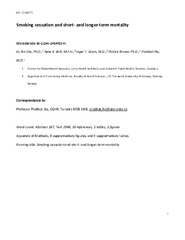Smoking Cessation and Short- and Longer-Term Mortality
Permanent link
https://hdl.handle.net/10037/36559Date
2024-02-08Type
Journal articleTidsskriftartikkel
Peer reviewed
Abstract
METHODS - We pooled current or former versus never cigarette smoker hazard ratios from four national cohorts with linkage to death registries in the United States, United Kingdom, Norway, and Canada among adults 20 to 79 years of age from 1974 to 2018. We calculated excess risk differences and survival, comparing current or never smokers with age-specific cessation and cessation fewer than 3, 3 to 9, or 10 or more years earlier.
RESULTS - Among 1.48 million adults followed for 15 years, 122,697 deaths occurred. Adjusting for age, education, alcohol use, and obesity, current smokers had higher hazard ratios for death compared with never smokers (2.8 for women, 2.7 for men). Survival between 40 and 79 years of age was 12 and 13 years less in women and men, respectively, who smoked compared with never smokers (about 24 to 26 years of life lost for smokers who died from smoking combined with zero loss for smokers who did not die from smoking). Former smokers showed lower hazard ratios (1.3 in both women and men). Short-term cessation for fewer than 3 years was associated with a lower excess risk of 95% in women and 90% in men younger than 40 years of age, with notable beneficial associations also in women and men 40 to 49 years of age (81% and 61%, respectively) and 50 to 59 years of age (63% and 54%, respectively). Cessation at every age was associated with longer survival, particularly cessation before 40 years of age. Among all ages and compared with continued smoking, cessation of fewer than 3 years potentially averted 5 years of life lost and cessation for 10 or more years averted about 10 years of life lost, yielding survival similar to that of never smokers.
CONCLUSIONS - Quitting smoking at any age, but particularly in younger years, was associated with lower excess mortality overall and from vascular, respiratory, and neoplastic diseases. Beneficial associations were evident as early as 3 years after cessation. (Funded by Canadian Institutes of Health Research [FDN-154277].)


 English
English norsk
norsk